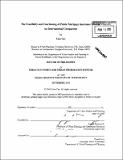The feasibility and functioning of public mortgage insurance models : an international comparison
Author(s)
Cao, Liou
DownloadFull printable version (21.88Mb)
Other Contributors
Massachusetts Institute of Technology. Dept. of Urban Studies and Planning.
Advisor
Joseph Ferreira, Jr.
Terms of use
Metadata
Show full item recordAbstract
Public mortgage insurance (MI) is one type of supply-side government intervention in housing finance. It is an important component of the modem housing finance market, employed to expand homeownership and provide credit enhancement to mortgage loans. This research explores the feasibility and functioning of public MI, by conducting an international comparison of three representative public MI programs: the U.S. Federal Housing Administration; the Dutch Homeownership Guarantee Fund; and the Mexican Federal Mortgage Corporation. The main purpose is to build an integrated framework for policymakers when considering a public MI scheme, from institutional, financial, and operational perspectives. Research methodologies used include case studies, interviews, Monte Carlo simulation models, and regression analyses. The analytical framework of this research comprises three research questions: a) What are the primary economic problems in housing and housing finance markets that cause market inefficiency and hence call for government intervention in the form of public MI? b) What are the implied liabilities imposed on the backing government of sponsoring a public MI enterprise? and c) What are the potential economic problems that can result from the creation of a public MI system? (cont.) Answers to these questions indicate that public MI can be an effective policy tool to address particular housing market inefficiencies. However, a good fit between public MI and a nation's housing and housing finance markets entails many factors, including economic, financial, legal, political, institutional, and even cultural. Public MI should be designed and priced properly to maintain its financial soundness over the long term, without imposing "hidden" liabilities on the backing government. Certain institutional arrangements and operational strategies are necessary to ensure public MI's relative independence and to control market distortions stemming from its presence. This research contributes to the knowledge base for any country considering a public MI scheme to boost its housing market development. It is intended to offer much needed insight into the economic rationale, financial viability, institutional and legal infrastructure, and operational strategies of government-sponsored MI programs, and help policymakers make informed decisions based on a holistic socio-economic view of the public MI.
Description
Thesis (Ph. D.)--Massachusetts Institute of Technology, Dept. of Urban Studies and Planning, 2005. Includes bibliographical references (p. 187-194).
Date issued
2005Department
Massachusetts Institute of Technology. Department of Urban Studies and PlanningPublisher
Massachusetts Institute of Technology
Keywords
Urban Studies and Planning.